Free Opera—You Get What You Pay For: A review of “La Bohème”
At 6pm on June 20th, Cunningham Park looked ordinary, at first glance. Then the stage erected for tonight’s performance loomed into view, as did the dozens of people already congregated on tarps, lawn chairs, and blankets. A small area in front of the stage was barricaded off and some white lawn chairs were already set up there. A man wearing a bowtie and a tux stood behind the barricade and signed autographs. His incongruity with the rest of the scene drew our attention and I sent out my minion, Dazvsemir, to gather information and possibly a playbill.
This was our view when we got there
Not knowing what to expect was probably a boon. All we knew was that we had some free, accessible culture coming our way and that we should probably show up early to make sure we could see some of it. The preparations for La Bohème at Cunningham Park were few (on our part, the park and the city went to great lengths) and although they involved sandwiches, the said preparations did not involve finding out the plot. I called a friend who saw the second part of the Opera at another park and she told me it was much like Moulin Rouge: a prostitute is loved by two men, one rich, one poor, and eventually dies pathetically of TB. My friend didn’t get the playbill, you see. I wish she were right about the plot.
La Bohème is actually about—as the title implies—a bunch of Bohemians. And as is proper, they are lazy, think themselves superior to anyone with money, and yet are willing to live off anyone who will lend them room and board while ridiculing teh humanitarian at the same time. They are unwilling to take responsibility for anyone, including themselves. When chilly, they find it much more satisfying to burn pages of a play painstakingly written hours before than to go out and find some old newspapers. Honestly, what I got from the summary was that we were about to see the precursor of musicals such as “Rent.” And I was basically right.
Middle-aged and stout men in tuxes and bowties played the Bohemians. The two female leads were in beautiful and sparkly dresses—the more tragic one, Mimi, radiated light from every point of her body. The orchestra took over the stage, leaving a strip for the opera singers and their microphones. Obviously, there wasn’t much action beyond facial expression and some gestures.
Marcello and Rodolfo as played by Dwayne Croft and Roberto Aronica, respectively.
At this point the elderly converged upon us and effectively blocked our view. They shooshed each other intermittently between asking for sandwiches and passing around bags of candy. A lost geriatric sometimes stumbled into our camp looking for his tribesmen, carefully wielding a cell phone and getting shushed.
The conditions at about 8p: the elderly, as far as the eye could see.
Only by following the summary of the play could we tell what was happening as the piece was set in Paris, the singing was in Italian and we were, for the most part, monolingual Americans. There is a strange idea propagated that it is OK to sit there and listen for hours to a story told in song when the language is one you do not know. Sure, some enjoyment can still be gotten from the melody and the professionally polished voices, but really, most of the experience goes right over the non-Italian speaker’s head.
I was fortunate enough to see an opera before, in a language I actually knew. That opera was based on Pushkin’s ‘Yevgeny Onegin.” There was an amazing backdrop and scenery and it was not necessary to know what the story was just to understand what was happening on stage. The singers were also actors and if they were supposed to be fighting, they fought, if they were walking in a garden, a garden was provided and they walked in it. This was, of course, an opera I actually paid to see. The Metropolitan Opera in the Park was free, and so the experience was much like that of a patient with Medicaid: you will be served nominally, with only the bare minimum allotted.
Now back to the plot. As mentioned before, the starving artists are burning their work for warmth, until another starving artist blunders in with food, fuel and funds he was given by some eccentric who was probably starving himself. They celebrate until the landlord wanders in, whom they ridicule and then throw out into the street. Finally, the sensitive one, and the one most dedicated to his art, Rodolfo, decides to stay back and try to work while the rest go out to celebrate. He hears a knock on the door and so meets Mimi whose candle went out on the stairs. They fall madly in love and sing about what it’s like to be them for some time.
During Act II, Marcello, the other starving artist, sees his ex-girlfriend, Musetta, on an arm of a well off although elderly man and they start an exchange in song. Finally, a very dramatic piece follows about how Musetta’s foot is paining her. She sends her now outdated beau away and falls into the arms of Marcello while making sure their festivities are charged to the silly old man.
Act III begins with Mimi crying to Marcello about Rodolfo’s jealousy. Later she hides and Rodolfo himself shows up to bitch about Mimi’s flirtations. Finally he reveals that he is really concerned about her tuberculosis and how it’s getting worse and worse. Basically, he can’t take care of her and would prefer to just not have her around. Mimi runs out with tears and much coughing and, of course, offers to free him. Marcello goes off to watch Musetta flirt and the two lovers are left alone to sing until they decide to stay together until spring. The assumption I am left to is that although Mimi is dying, they don’t expect her to become a hospice case until later, which is when the abandonment is planned for.
Act IV begins with the two bachelors whining about loneliness and then the rest of the male Bohemians showing up and everyone becoming cheery. Until, that is, Musetta shows up to inform them that Mimi is downstairs and has come to die in her ex-lover’s arms. A flurry of activity follows where each man, after letting Mimi succumb to illness alone, suddenly decides to do something as silly as to sell their only coat to buy her the medicine that cannot possibly help her now. Of course, she is brought upstairs, and per her wish, dies in the arms of the stout man with the tux on, who then cries out quite dramatically that he can’t believe she has died.
My view
The characters were all quite one-dimensional. Mimi was cheerless, even when in love, although never poignant. The male Bohemians were mostly indistinguishable except for Shaunard, who is not really a major character but possibly had most of the funny lines. Musetta was feisty and bawdy, which I enjoyed. Her raucous laugh generally brought me back to the stage if I fell into a reverie.
Bats flew over our heads as nature dimmed the lights. Bugs crawled over us despite the repellant we lathered ourselves with. The air became chillier and chillier until I was wrapped up in the blankets we sat one. The bats squeaked desperately by, their sonars probably thrown off by the acoustics of the opera. A bloodcurdling screech sounded far off, maybe a jogger attacked, and the opera went on with the main hero saying good-bye to his TB-ridden girlfriend or at least trying to.
The entire cast in final throes
Despite everything, I must admit that I enjoyed La Bohème; the music and the vocals conveyed the story well even though I didn’t understand most of the language. I was drawn into the story even though a different sort of suspension of disbelief was required—you are to simultaneously admire the singers’ smart outfits and believe them to be poor artists who are struggling to survive. I particularly enjoyed the way the orchestra and the chorus, which appeared in Act II, and represented events which were like asides to the main plot. Particularly well done were the pieces where a toy maker was supposed to be pursued by poor children desperate for a toy and later the soldiers who marched past the Bohemians’ favorite café. I enjoyed watching the conductor as well, for he was manic and his elderly body achieved the fluidity of a dancer during the high drama periods.

From left to right: Colline/Andrew Gangestad, Schaunard/Jeff Mattsey, Musetta/Mary Dunleavy, Marcello/Dwayne Croft, Rodolfo/Roberto Aronica, Mimi/Hey-Kyung Hon and the excellent conductor Gareth Marrell.
Overall, this isn’t something I’m bound to do again. Next time I go to see an opera, I’ll just pay for it with cash instead of feelings of generalized hate.
Copyright © 2007 Eat The Lemons
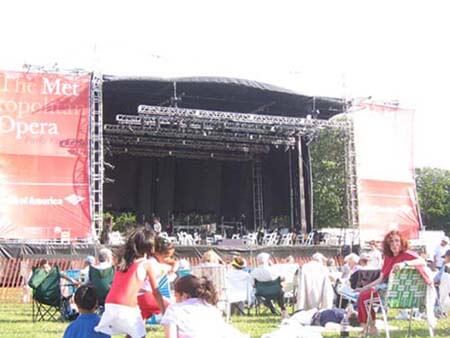
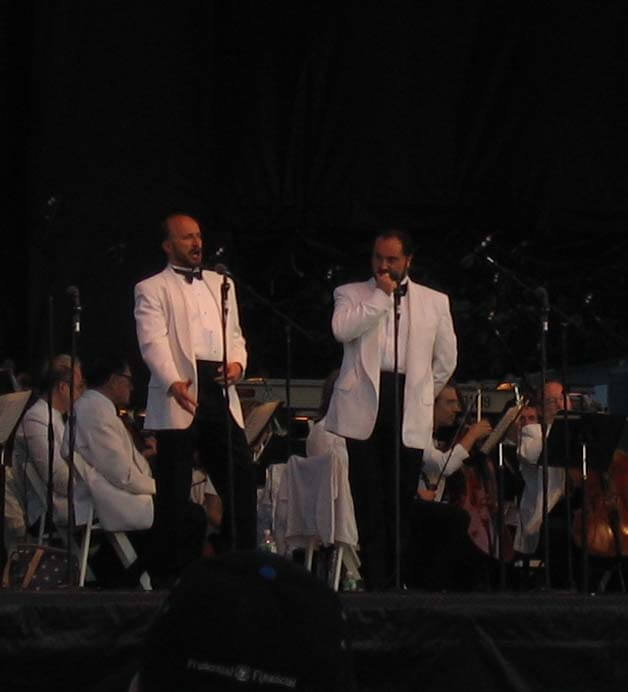
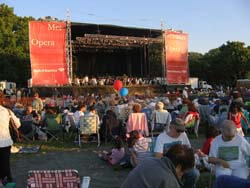
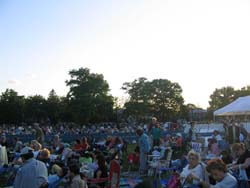
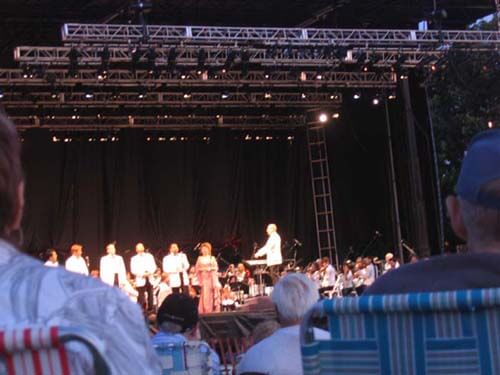
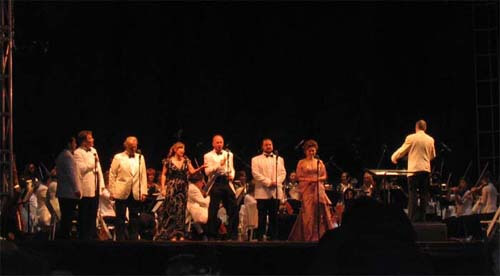
during the second act i noticed alot of moths flying up into the hot stage lights, getting burned to death, then fluttering down onto the stage. i used this to envision a snowy day in paris. thank god for nature.
oh, and ur mention of sandwiches reminded me to eat today. thanks again.